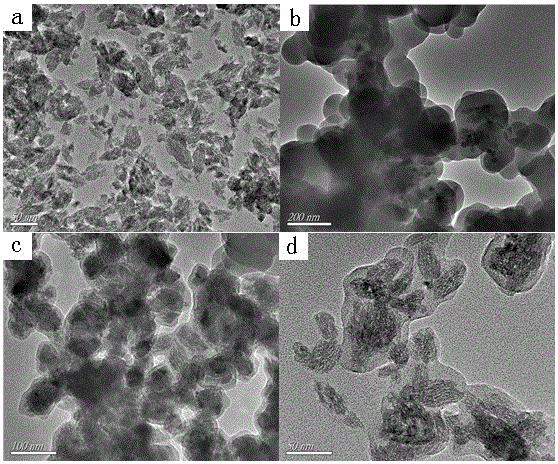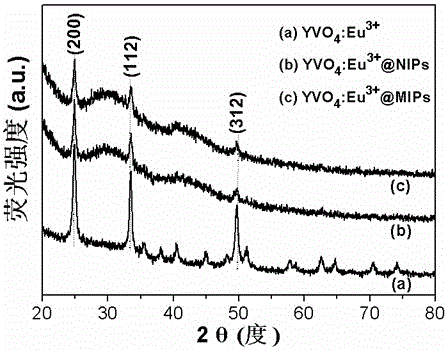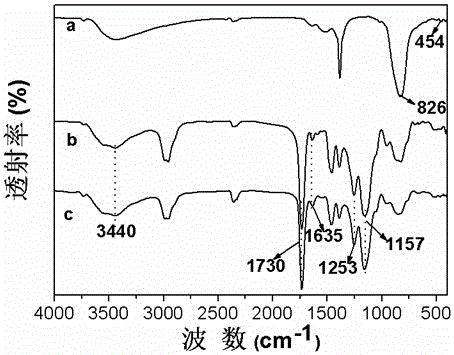Preparation method of rare earth-doped core-shell fluorescent imprinted polymer
A technology of imprinting polymers and fluorescent polymers, applied in fluorescence/phosphorescence, chemical instruments and methods, luminescent materials, etc., can solve problems such as limited applications, and achieve the effects of large stokes shift, high chemical stability, and high luminous intensity
- Summary
- Abstract
- Description
- Claims
- Application Information
AI Technical Summary
Problems solved by technology
Method used
Image
Examples
Embodiment 1
[0034] Preparation of europium-doped yttrium vanadate nanoparticles (YVO 4 :Eu 3+ ): a) First, 0.95 mmol of yttrium oxide (Y 2 o 3 ) and 0.05 mmol europium oxide (Eu 2 o 3 ) was dissolved in excess dilute nitric acid, heated and evaporated to remove excess nitric acid to obtain nitrates of yttrium and europium, and dispersed in 40mL of water; b) followed by 2.0mmol ammonium metavanadate (NH 4 VO 3 ) into 40mL of water and sonicate for 10min, then use 2M NaOH solution to adjust the pH value from 13 to NH 4 VO 3 Dissolve completely to a clear solution. The solution prepared in step a) was then added dropwise to NH 4 VO 3 In the transparent solution of 80°C, vigorously stirred for 2h, the white precipitate was washed with ethanol and water respectively, and dried at 60°C for use. The resulting nanoparticles are figure 1 as shown in a.
[0035] Preparation of core-shell molecularly imprinted fluorescent polymer (YVO 4 :Eu 3+ @MIPs): Weigh 10mgYVO 4 :Eu 3+ Disperse ...
Embodiment 2
[0037] Preparation of core-shell molecularly imprinted fluorescent polymer (YVO 4 :Eu 3+ @MIPs): Weigh 80mg of YVO prepared above 4 :Eu 3+ Disperse in 50mL of methanol and water mixed solution (4 / 1, v / v), then add 0.1mmol template molecule cyhalothrin (LC), 0.4mmol functional monomer methacrylic acid (MAA) and 2.0mmol The cross-linking agent ethylene glycol dimethacrylate (EGDMA) was dispersed evenly by ultrasonic, and the air in the three-necked flask was exhausted by passing nitrogen gas for 30 minutes, and 10 mg of the initiator azobisisobutyronitrile (AIBN) was added, and the temperature was raised to 50°C and heated for 6.0 h, and then continue to react at 60° C. for 18 h until the polymerization is completed. The product was washed 3 times with water and ethanol. Then, the mixture of methanol and acetic acid (95 / 5, v / v) was used as the extract solution for Soxhlet extraction to remove the template molecule LC, and vacuum-dried at 50°C. The resulting polymer is figu...
Embodiment 3
[0039] Preparation of core-shell molecularly imprinted fluorescent polymer (YVO 4 :Eu 3+ @MIPs): Weigh 50mg of YVO prepared above 4 :Eu 3+ Disperse in 50mL of methanol and water mixed solution (4 / 1, v / v), then add 0.1mmol template molecule cyhalothrin (LC), 0.4mmol functional monomer methacrylic acid (MAA) and 2.0mmol The cross-linking agent ethylene glycol dimethacrylate (EGDMA) was dispersed evenly by ultrasonic, and the air in the three-necked flask was exhausted by passing nitrogen gas for 30 minutes, and 10 mg of the initiator azobisisobutyronitrile (AIBN) was added, and the temperature was raised to 50°C and heated for 6.0 h, and then continue to react at 60° C. for 18 h until the polymerization is completed. The product was washed 3 times with water and ethanol. Then, the mixture of methanol and acetic acid (95 / 5, v / v) was used as the extract solution for Soxhlet extraction to remove the template molecule LC, and vacuum-dried at 50°C. The resulting polymer is figu...
PUM
| Property | Measurement | Unit |
|---|---|---|
| diameter | aaaaa | aaaaa |
| length | aaaaa | aaaaa |
Abstract
Description
Claims
Application Information
 Login to View More
Login to View More - R&D
- Intellectual Property
- Life Sciences
- Materials
- Tech Scout
- Unparalleled Data Quality
- Higher Quality Content
- 60% Fewer Hallucinations
Browse by: Latest US Patents, China's latest patents, Technical Efficacy Thesaurus, Application Domain, Technology Topic, Popular Technical Reports.
© 2025 PatSnap. All rights reserved.Legal|Privacy policy|Modern Slavery Act Transparency Statement|Sitemap|About US| Contact US: help@patsnap.com



